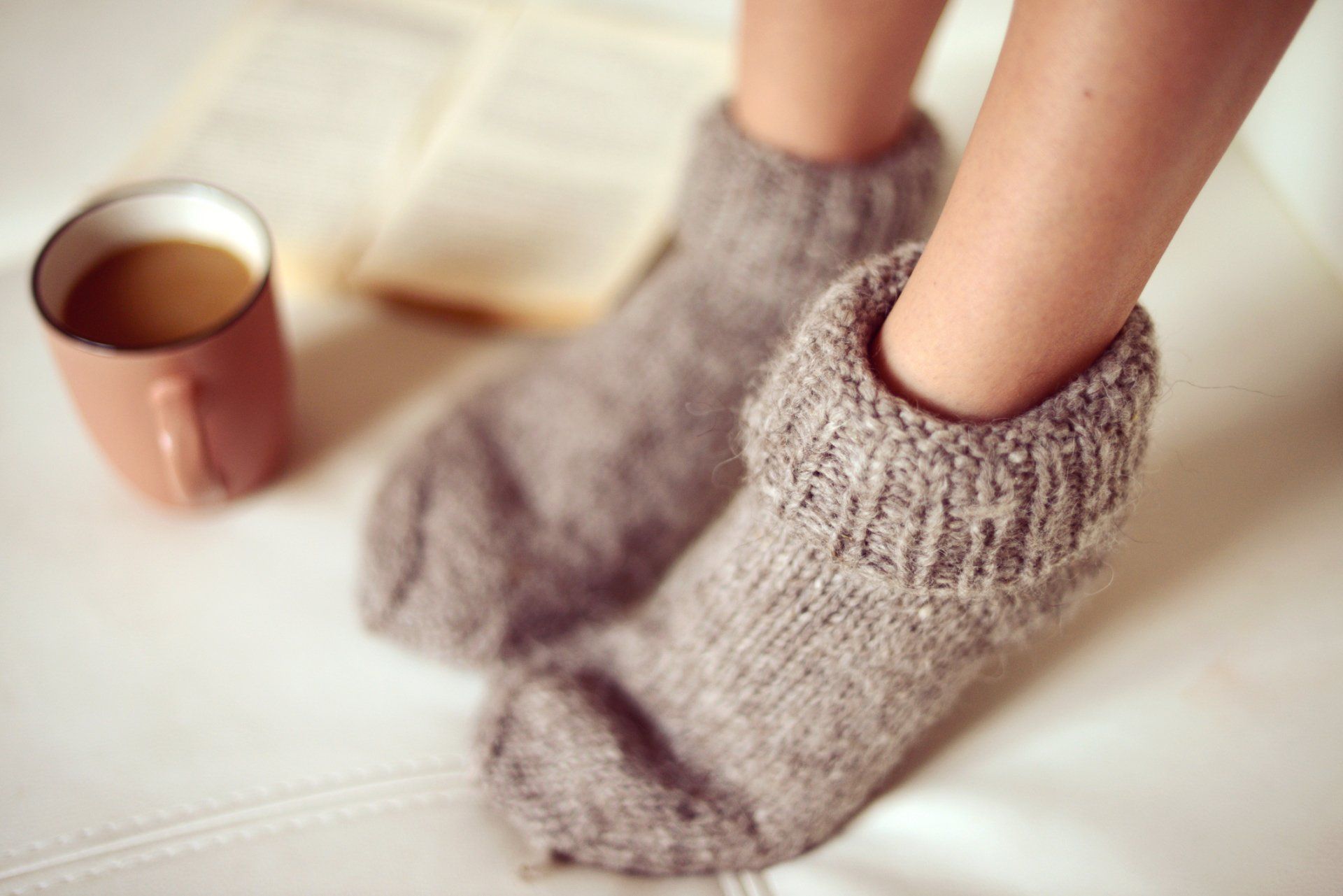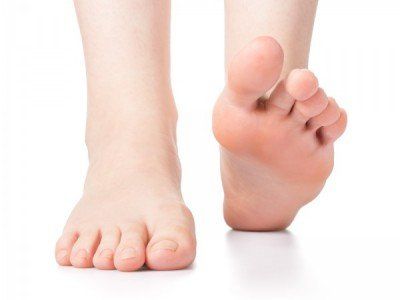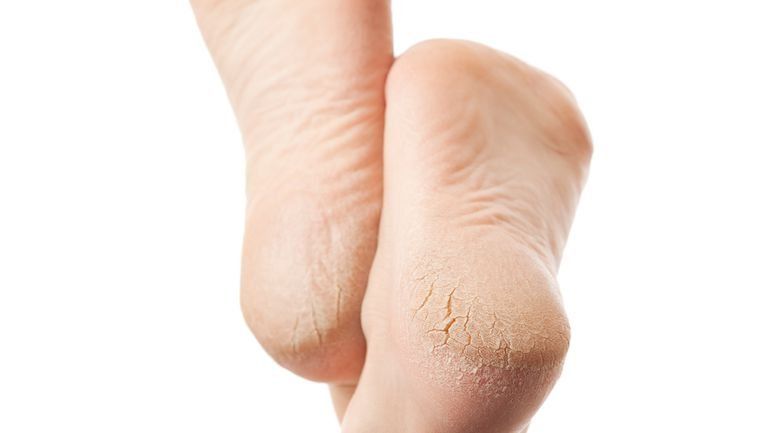CH34687

WHAT ARE CHILBLAINS? They are small, itchy red (sometimes purple) lesions on the skin which can become painful during the colder season. They can lead to the skin become dry and cracking exposing the foot to the risk of infections. They can occur in many places not just the toes, such as; the fingers, nose and lobes of the ears. WHY DOES IT HAPPEN? Chilblains occur when the tiny blood vessels under the skin becomes constricted in the cold weather, which in turn leads to reduced blood flow. As the skin re-warms there is some leakage of fluid from the blood vessels into the tissues which in some way causes areas of inflammation and swelling leading to chilblains. SYMPTOMS: · Small itchy, red areas on the skin · They can form a blister which may delay healing · They can cause a break in the skin causing a painful ulcer which can be prone to infection · Can appear cyanosed and appear dark blue or purple in colour · A burning sensation on the skin · Swelling in the affected area WHO IS LIKELY TO GET IT? Anyone can get them but some are more susceptible than others such as; · People with poor circulation · Health problems involving blood vessels i.e. Raynaud’s phenomena, lupus. · Damp and cold conditions · Dietary factors · Hormonal imbalance · Rapid change of temperature · Anaemia · Smoking · Elderly and the very young as the body is not as efficient. WHAT DO I DO IF I GET THEM? · If you have a chilblain, the most important thing to remember is to avoid scratching it and use a light dressing over the affected area. · Use soothing lotions such as witch hazel, calamine lotion, balmosa or mixture of friars balsam and a weak solution of iodine (do not use balmosa or the mixture on broken skin) · If chilblains are broken or ulcerated, apply an antiseptic dressing such as iodine impregnated dressing. · If you have diabetes or undergoing medical treatment for foot and ankle ulceration please contact your GP practice or local podiatrist for assessment and appropriate consultation. PREVENTION: · Keep warm – making sure you have one hot meal a day, warming your hands before you go outside, wearing gloves and keeping your house well heated. · Wear good quality socks (sometimes 2 pair of socks are needed, if you get too hot you can always take one layer off). · Good footwear what will keep you warm, make sure they are not too tight either to prevent constriction of the blood flow. · Gently massage your feet with cream as this will boost your circulation and keep your skin hydrated and prevent the skin from cracking. · Do not walk barefoot on cold surfaces. · Avoid extreme temperatures if possible · Do not put feet in front of direct heat or on radiators or hot water bottles. · Regular exercise – this helps improve your circulation · Reduce or work towards quitting smoking – nicotine causes the blood vessels to constrict. WHAT SHOULD I DO IF I AM CONCERNED? If the problem is still persisting, does not heal within 2-3 weeks or concern you have an infection, please contact your GP. Alternatively, talk to a podiatrist about the options available regarding treatment of chilblains. you can contact an NHS podiatrist (via a GP referral, this is dependent on the CCG area and criteria) or a private practice podiatrist. In both cases, always ensure that any practitioners you visit are registered with the Health and Care Professionals Council (HCPC) Contact Soleful Ltd today via a simple phone call, text, email or fill in our online form and we will get back to you as soon as possible. Happy holidays and we wish you a happy new year.

Let's talk diabetes, a disorder with a hundred different faces and a thousand different complications, all which affects everyone differently. Diabetic foot ulcers occur as a result of various factors, such as mechanical changes in conformation of the bony architecture of the foot, peripheral neuropathy, and atherosclerotic peripheral arterial disease. The mechanism involves a non-enzymatic glycation that predisposes ligaments to stiffness and neuropathy that causes loss of protective sensation and loss of coordination of muscle groups in the foot and leg, both of which increase mechanical stresses during ambulation. The result of loss of sensation in the foot is repetitive stress, unnoticed injuries, fractures, heat, cold, or even unnoticed damage from a blunt or sharp object, structural foot deformities, and eventual tissue breakdown that cause blistering and ulceration. Diabetes is a serious condition not to be taken lightly, which is why it is important to see your podiatrist for an annual review or even regularly to ensure you have the best foot health possible. A Podiatrist can provide a thorough assessment, treatment, a care plan to empower you and educate you further on how to look after yourself and your feet, spot signs of danger and what to do in case of an emergency. Prevention and education is key to a healthy lifestyle, a healthy you and also reducing the risk of limb loss which is on the increase unfortunately. #DiabetesIsNotaTrend #Podiatry #Podiatrist #FootHealthAwareness #Chiropody #Soleful #Empowerment #Education #Prevention Follow us on instagram @solefulltd for daily updates

What causes cracked heels? - Dehydrated, dry and loss of moisture which is the most common cause of cracked heels. - Exposed footwear such as open back footwear, and poorly fitted footwear - pressure related such as spending prolong period on your feet - Biomechanical abnormalities - Ageing skin, as we get older our skin changes loses its lovely elasticity causing dry and cracked heels - Obesity and being overweight can increase pressure on the fat pad leading to fissures. - Hygiene and ignoring your foot health - Water on your feet can take away natural oils from your skins and leave you with dry and or cracked skin. - Medical conditions such as diabetes, neuropathy, hypothyroidism, thyroid, circulation, dermatological conditions such as ezcema and psoriasis - Weather, the change of weather can be harsh on your skin especially your feet. Mixture of dry, callosity and pressure area can lead to painful heels causing the area to be fragile to bleeding, splitting, risk of ulceration and taking a long time to heal. How to reduce dry and cracked/fissured heels: 1. Check feet daily 2. Gently file callus skin 3. Moisturise daily using a urea based foot cream designed to soften hard skin and provide high nourishment 4. Alternate footwear 5. See a Podiatrist to remove callus skin manually, get advice and recommendations to reduce your risk of fissured heels and provide you a full assessment. #Soleful #Podiatry #Podiatrist #HappyFeetHappyYou #FootHealthAwareness #Chiropody #CrackedHeels #Fissure #PainfulHeels Follow us on instagram at @solefulltd

WHAT ARE CHILBLAINS? They are small, itchy red (sometimes purple) lesions on the skin which can become painful during the colder season. They can lead to the skin become dry and cracking exposing the foot to the risk of infections. They can occur in many places not just the toes, such as; the fingers, nose and lobes of the ears. WHY DOES IT HAPPEN? Chilblains occur when the tiny blood vessels under the skin becomes constricted in the cold weather, which in turn leads to reduced blood flow. As the skin re-warms there is some leakage of fluid from the blood vessels into the tissues which in some way causes areas of inflammation and swelling leading to chilblains. SYMPTOMS: · Small itchy, red areas on the skin · They can form a blister which may delay healing · They can cause a break in the skin causing a painful ulcer which can be prone to infection · Can appear cyanosed and appear dark blue or purple in colour · A burning sensation on the skin · Swelling in the affected area WHO IS LIKELY TO GET IT? Anyone can get them but some are more susceptible than others such as; · People with poor circulation · Health problems involving blood vessels i.e. Raynaud’s phenomena, lupus. · Damp and cold conditions · Dietary factors · Hormonal imbalance · Rapid change of temperature · Anaemia · Smoking · Elderly and the very young as the body is not as efficient. WHAT DO I DO IF I GET THEM? · If you have a chilblain, the most important thing to remember is to avoid scratching it and use a light dressing over the affected area. · Use soothing lotions such as witch hazel, calamine lotion, balmosa or mixture of friars balsam and a weak solution of iodine (do not use balmosa or the mixture on broken skin) · If chilblains are broken or ulcerated, apply an antiseptic dressing such as iodine impregnated dressing. · If you have diabetes or undergoing medical treatment for foot and ankle ulceration please contact your GP practice or local podiatrist for assessment and appropriate consultation. PREVENTION: · Keep warm – making sure you have one hot meal a day, warming your hands before you go outside, wearing gloves and keeping your house well heated. · Wear good quality socks (sometimes 2 pair of socks are needed, if you get too hot you can always take one layer off). · Good footwear what will keep you warm, make sure they are not too tight either to prevent constriction of the blood flow. · Gently massage your feet with cream as this will boost your circulation and keep your skin hydrated and prevent the skin from cracking. · Do not walk barefoot on cold surfaces. · Avoid extreme temperatures if possible · Do not put feet in front of direct heat or on radiators or hot water bottles. · Regular exercise – this helps improve your circulation · Reduce or work towards quitting smoking – nicotine causes the blood vessels to constrict. WHAT SHOULD I DO IF I AM CONCERNED? If the problem is still persisting, does not heal within 2-3 weeks or concern you have an infection, please contact your GP. Alternatively, talk to a podiatrist about the options available regarding treatment of chilblains. you can contact an NHS podiatrist (via a GP referral, this is dependent on the CCG area and criteria) or a private practice podiatrist. In both cases, always ensure that any practitioners you visit are registered with the Health and Care Professionals Council (HCPC) Contact Soleful Ltd today via a simple phone call, text, email or fill in our online form and we will get back to you as soon as possible. Happy holidays and we wish you a happy new year.

Let's talk diabetes, a disorder with a hundred different faces and a thousand different complications, all which affects everyone differently. Diabetic foot ulcers occur as a result of various factors, such as mechanical changes in conformation of the bony architecture of the foot, peripheral neuropathy, and atherosclerotic peripheral arterial disease. The mechanism involves a non-enzymatic glycation that predisposes ligaments to stiffness and neuropathy that causes loss of protective sensation and loss of coordination of muscle groups in the foot and leg, both of which increase mechanical stresses during ambulation. The result of loss of sensation in the foot is repetitive stress, unnoticed injuries, fractures, heat, cold, or even unnoticed damage from a blunt or sharp object, structural foot deformities, and eventual tissue breakdown that cause blistering and ulceration. Diabetes is a serious condition not to be taken lightly, which is why it is important to see your podiatrist for an annual review or even regularly to ensure you have the best foot health possible. A Podiatrist can provide a thorough assessment, treatment, a care plan to empower you and educate you further on how to look after yourself and your feet, spot signs of danger and what to do in case of an emergency. Prevention and education is key to a healthy lifestyle, a healthy you and also reducing the risk of limb loss which is on the increase unfortunately. #DiabetesIsNotaTrend #Podiatry #Podiatrist #FootHealthAwareness #Chiropody #Soleful #Empowerment #Education #Prevention Follow us on instagram @solefulltd for daily updates

What causes cracked heels? - Dehydrated, dry and loss of moisture which is the most common cause of cracked heels. - Exposed footwear such as open back footwear, and poorly fitted footwear - pressure related such as spending prolong period on your feet - Biomechanical abnormalities - Ageing skin, as we get older our skin changes loses its lovely elasticity causing dry and cracked heels - Obesity and being overweight can increase pressure on the fat pad leading to fissures. - Hygiene and ignoring your foot health - Water on your feet can take away natural oils from your skins and leave you with dry and or cracked skin. - Medical conditions such as diabetes, neuropathy, hypothyroidism, thyroid, circulation, dermatological conditions such as ezcema and psoriasis - Weather, the change of weather can be harsh on your skin especially your feet. Mixture of dry, callosity and pressure area can lead to painful heels causing the area to be fragile to bleeding, splitting, risk of ulceration and taking a long time to heal. How to reduce dry and cracked/fissured heels: 1. Check feet daily 2. Gently file callus skin 3. Moisturise daily using a urea based foot cream designed to soften hard skin and provide high nourishment 4. Alternate footwear 5. See a Podiatrist to remove callus skin manually, get advice and recommendations to reduce your risk of fissured heels and provide you a full assessment. #Soleful #Podiatry #Podiatrist #HappyFeetHappyYou #FootHealthAwareness #Chiropody #CrackedHeels #Fissure #PainfulHeels Follow us on instagram at @solefulltd


